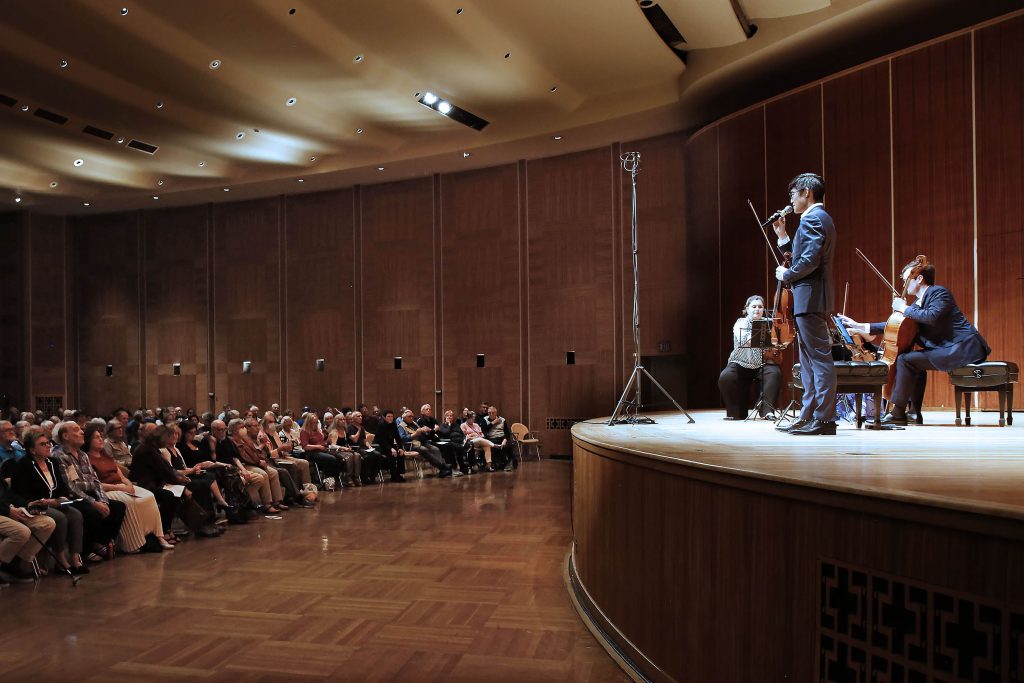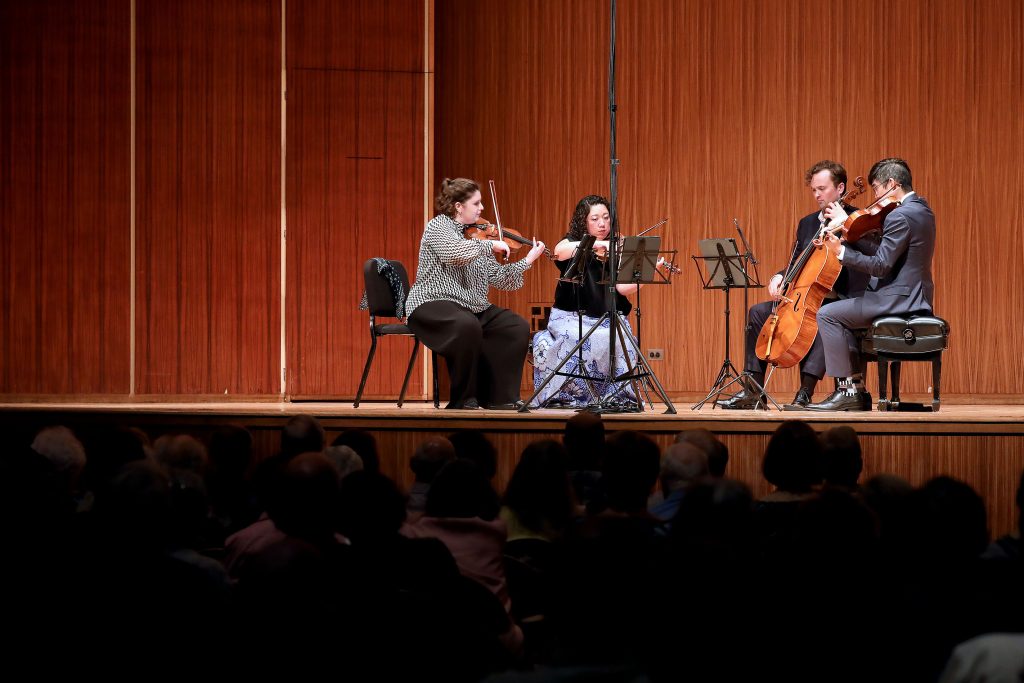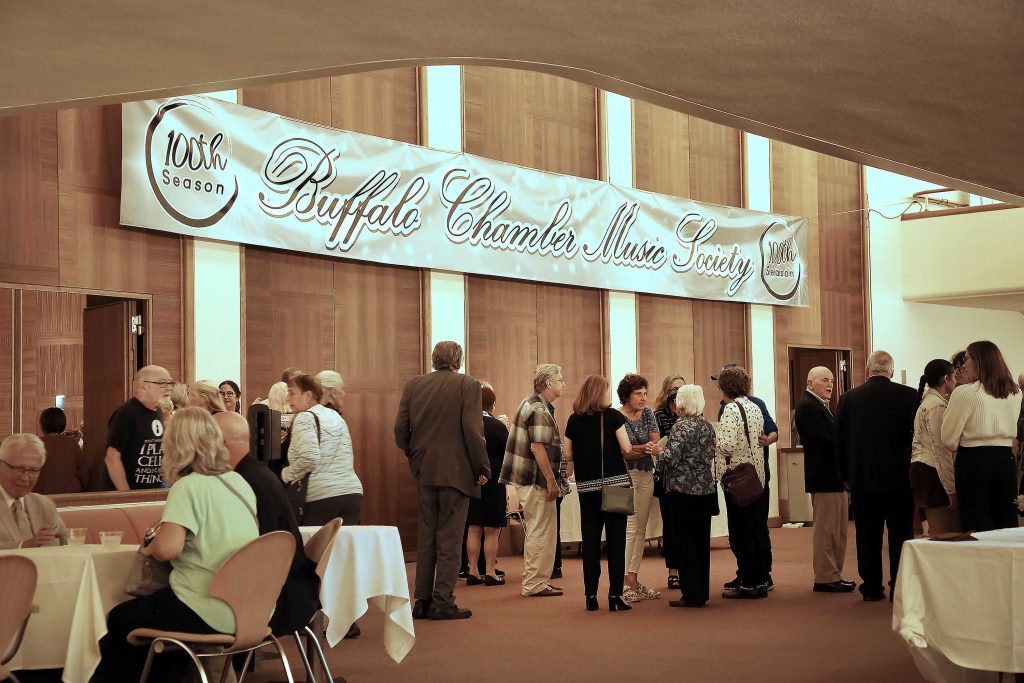100 Years of Chamber Music in Buffalo

It says something about Buffalo’s priorities that our oldest piece of public art is not a statue of a soldier or a statesman. It is a statue of Mozart.
The sculpture was put up in 1894 by the Buffalo Liedertafel, a German singing society. As you walk or cycle down the trail by the Buffalo History Museum, Mozart watches over you. On snowy days he wears a powdered wig. Returning his gaze, you find yourself thinking: This is no ordinary town.
Visitors to Buffalo included Mahler and Rachmaninoff, who worked on his Symphonic Dances while staying at the Lenox Hotel. And Tchaikovsky, who visited Niagara Falls and experienced the Cave of the Winds.
The Buffalo Philharmonic Orchestra performs in Kleinhans Music Hall, a venue admired throughout the world. The Slee Beethoven Quartet Cycle, a phenomenon found only in Buffalo, brings the world’s top string quartets, every year, to play every single quartet Beethoven wrote. It is the legacy of lawyer and philanthropist Frederick Slee, who, well, loved Beethoven. And one of our biggest successes, the Buffalo Chamber Music Society, is also unique in the world.
Celebrating its 100th anniversary this season, it is among the nation’s oldest chamber music organizations – older than the chamber music series led by the Library of Congress in Washington D.C., and the Frick Collection in New York. Only the Coleman Chamber Music Association, in California, is older.
The term “chamber music” refers simply to music played by small ensembles. The beginnings of this series were of a grassroots nature, typical for Buffalo. In the 1920s, three Buffalo women, after hearing a string quartet, formed what they called the Buffalo Symphony Society. Their plans led to the Buffalo Symphony Orchestra, a precursor to the BPO. And to a string quartet, drawn from the orchestra.
The string quartet gave its first concert on March 12, 1924, playing Mozart and Schubert in the new Hotel Statler. Soon, the concert series began playing host to out-of-town ensembles.
When the Great Depression hit, the orchestra folded. The chamber music endeavor, less expensive, survived. Continuing at the Statler, it welcomed luminaries including French violinist Jacques Thibaud; composer and violist Paul Hindemith; and the Budapest Quartet, perhaps the world’s most famous quartet in the first half of the 20th century. The Russian musicians who made up the Budapest Quartet must have liked what they found here. They would go on to take up residence in Buffalo for some years.
In 1940, when Kleinhans Music Hall was built, the Chamber Music Society concerts moved there – to the elegant Mary Seaton Room. They still take place there, and they are something to experience.
Eye to eye with musicians

When you go to a Buffalo Chamber Music Society concert, the magic starts before the music even begins.
The doors to the Mary Seaton Room are open, commanding your attention. These are not ordinary doors. They are two stories high. Listeners are having drinks in the lobby. Excitement is in the air.
Walking through those giant doors into the Mary Seaton Room, you feel a sense of awe – however also a charming sense of informality. Perhaps the artists are already on stage, taking questions in a pre-concert interview. Listeners are drifting in, in groups and by themselves. You may choose where you want to sit – it’s open seating, on folded chairs. Grab a seat in the front, and you may wind up eye-to-eye with the musicians.
As you settle into your seat, it is irresistible to imagine the artists who have performed in this room, as part of this series. In 1957, 950 fans crowded the room to see guitarist Andras Segovia. Flutist Jean-Pierre Rampal played here. And the violinist Gil Shaham.
The great Guarneri Quartet’s farewell concert drew such a crowd that some listeners had to be seated on stage with the musicians. I was one of them. I’ll never forget it.
“It’s a different feeling,” says Clementina Fleshler, the executive director of the Buffalo Chamber Music Society. “It’s like ‘Oh, my God, I’m part of this thing here.”
Fleshler, who has headed the Buffalo Chamber Music Society for several decades, is known for presenting the greats. At the same time, she is always keeping an eye on the national scene, scouting new talent.

Under her leadership, the series has grown to include free Gift to the Community concerts, which feature up-and-coming musicians. Fleshler chooses them carefully. She goes every year to New York for the Young Concert Artists International Auditions, just for this purpose.
“It’s fabulous to hear these young people,” she says. “It’s the highlight of my year to see these kids.”
A musician herself, Fleshler only recently retired from the BPO, where she had a long and stellar career as a first violinist. She knows what to listen for, and she listens for it.
She loves to raise the possibility that audiences will later be saying, “We heard them when ….” It has a way of happening.
Shuai Wang, a young pianist, stands out as one such coup. “He got the best writeup in the New York Times,” she exults. “It was like Rachmaninoff was reborn.”
Japanese-born violist Naoko Shimizu was another.
“We took her to Niagara Falls, and on the way home, I asked her, ‘What are you going to do now?’” Fleshler remembers. “She said, ‘I don’t know. I’ve been offered a job in an orchestra. I don’t know if I should take it.’”
Fleshler asked what the job was, and where. Her jaw dropped at the answer: associate principal violist in the Berlin Philharmonic.
“I think you should take the job,” she managed to tell Shimizu.
“So that’s what she did, and that’s where she is now,” she laughs. “Can you imagine thinking about it? Should I take it, should I not take it? It seems crazy to me.”
‘An acquired taste’

Fleshler has put together a book that celebrates the series on the occasion of its 100th anniversary. On the phone, asked to name highlights off the top of her head, she pauses for a second. There have been so many.
“We had Gil Shaham for two recitals. That was exciting for me,” she remembers. “It was more intimate than seeing him with the orchestra. It really was fabulous. He brought his wife and little son. Those days are gone,” she sighs. Shaham, who just performed on the Buffalo Philharmonic Orchestra’s season-opening concert, now has gray hair.
Soloists have a singular kind of stardom. However, the ensembles who perform on the series have a different dynamic that can be just as fascinating.
String quartets can exhibit a back-and-forth that can be likened to the interplay astute fans might observe in a vocal quartet, or a rock group. Chamber music fans can enjoy seeing the same group over and over, noticing how they evolve as years go by.
This season’s series offers plenty of opportunity to do that. It opened Oct. 3 with the Aizuri Quartet. It goes on to include the Danish Quartet; the Manhattan Chamber Players; the Frautschi/Manasee/Nakamatsu trio; the Juilliard Quartet; the Takacs Quartet; and the Doric Quartet.
Fleshler is looking forward to the Juilliard Quartet. The group, now legend, first appeared on the series in 1948.
“I think chamber music is a kind of acquired taste,” Fleshler says. “It’s not for everybody. You can’t sell it to everybody.
“But once someone comes to the concerts and starts seeing how the musicians react to each other when they’re playing – when the first first violinist looks at the violist when they get to a certain passage – that is something you don’t see in the orchestra.”
“I had somebody come to a concert for the first time, and say, ‘I didn’t know there was so much interplay.’
“That’s what chamber music is.”

